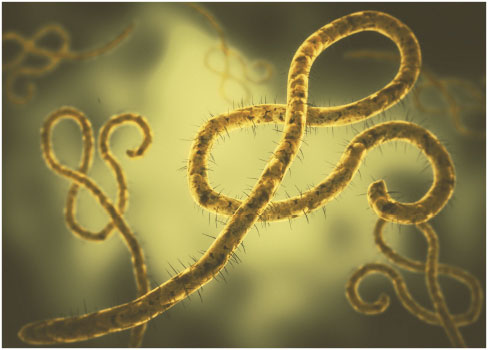
Error: No layouts found

Researchers at Einstein and the U.S. Army Medical Research Institute of Infectious Disease (USAMRIID) have engineered the first antibodies that can potently neutralize the two deadliest strains of the virus that causes Ebola hemorrhagic fever. The findings, made in mice, are a significant step toward immunotherapies that are effective against all strains of Ebola virus that cause human disease. The study was published in January in Scientific Reports.
“A broadly effective immunotherapy for Ebola virus would be a tremendous advance, since it’s impossible to predict which strain of the virus will cause the next outbreak,” says study co-leader Jonathan R. Lai, Ph.D., an associate professor of biochemistry at Einstein. The other study co-leader is John M. Dye, Ph.D., branch chief of viral immunology at USAMRIID.
Zaire Ebola virus (EBOV) was responsible for the 2014 Ebola outbreak in West Africa, the largest in history. The second-most pathogenic strain of Ebola virus is Sudan Ebola virus (SUDV), which has been responsible for large outbreaks in the past.
Although a Zaire-specific vaccine is in clinical trials, no vaccine has yet been approved for preventing infection from any strain of Ebola virus.
In previous work, Dr. Lai and his colleagues used a technique called synthetic antibody engineering to create the first antibodies against SUDV. Those antibodies were designed to bind to SUDV’s surface glycoprotein, which the virus uses to gain entry into host cells. Since SUDV’s glycoprotein shares just 55 percent of the amino acid sequences found in EBOV’s glycoprotein, antibodies against SUDV do not neutralize EBOV.
In the current study, Dr. Lai’s team engineered “bispecific” antibodies that contain key glycoprotein-binding sequences from both the EBOV and SUDV antibodies. The bispecific antibodies effectively neutralized both EBOV and SUDV in tissue-culture studies. In addition, the antibodies provided high levels of protection for mice that had been exposed to lethal doses of either of the viruses.
The bispecific antibodies must still be tested in larger animals and in humans to show that they’re effective. If the new immunotherapy proves safe and effective for people, says Dr. Lai, it might best be suited for preventing local outbreaks from getting out of hand, as happened in the recent West African Ebola virus epidemic. “It’s also possible,” he notes, “that a therapy like this could be used prophylactically, to protect health workers or family members who come into contact with Ebola virus patients.”
Dr. Lai has now broadened his approach to Ebola virus therapy. He is developing antibodies and antibody cocktails aimed at neutralizing the three most dangerous Ebola virus species (Zaire, Sudan and Bundibugyo), as well as Marburg virus, a deadly pathogen closely related to Ebola virus.